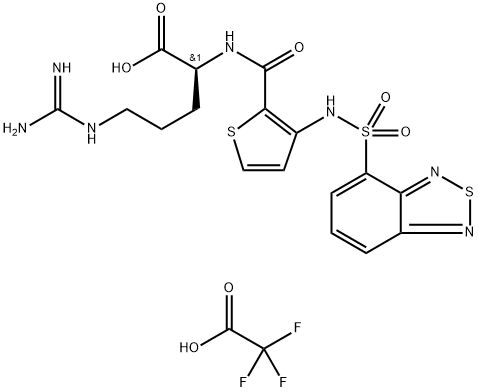1210945-69-9
 1210945-69-9 結(jié)構(gòu)式
1210945-69-9 結(jié)構(gòu)式
| 報(bào)價(jià)日期 | 產(chǎn)品編號 | 產(chǎn)品名稱 | CAS號 | 包裝 | 價(jià)格 |
| 2025/05/22 | HY-10799 | EG00229 | 1210945-69-9 | 1 mg | 636元 |
| 2025/05/22 | HY-10799 | CS-1273 EG00229 | 1210945-69-9 | 5mg | 1400元 |
| 2025/05/22 | HY-10799 | CS-1273 EG00229 | 1210945-69-9 | 10mM * 1mLin DMSO | 1884元 |
常見問題列表
IC50: 8 μM ( 125 I-VEGF-A binding to PAE/NRP1); 3 μM (bt-VEGF-A binding to purified NRP1 b1 domain).
EG00229 (Compound 2; 0-100 μM; 48 hours; A549 cells) treatment causes a significant reduction in cell viability over a 48 hours incubation.
EG00229 (Compound 2) demonstrates inhibition of VEGF-A binding to NRP1 and attenuates VEGFR2 phosphorylation in endothelial cells. Inhibition of migration of endothelial cells is also observed in HUVECs.
EG00229 (Compound 2) selectively inhibits radiolabeled
125
I-VEGF-A binding to porcine aortic endothelial (PAE)/NRP1, but not VEGFR2-expressing cells, with an
IC
50
of 8 μM. EG00229 also inhibits VEGF-A binding to lung carcinoma A549 and prostate carcinoma DU145 cells, which express NRP1, but not VEGFR1 and VEGFR2, with similar potency. Binding of VEGF-A to human umbilical vein endothelial cells (HUVECs), which express VEGFR2, VEGFR1, and NRP1, is also inhibited by EG00229 with an
IC
50
of 23 μM.
Cell Viability Assay
| Cell Line: | A549 cells |
| Concentration: | 0 μM, 10 μM, 30 μM, 100 μM |
| Incubation Time: | 48 hours |
| Result: | Caused a significant reduction in cell viability. |
EG00229 (0-10 mg/kg; intraperitoneal injection; three times per week; for 4 weeks; NSG mice) treatment substantially reduces tumor growth and visible vascularization.
| Animal Model: | 6-week old female NOD scid IL2 receptor gamma chain knockout mice (NSG mice) with ECS cells |
| Dosage: | 0 mg/kg, 10 mg/kg |
| Administration: | Intraperitoneal injection; three times per week; for 4 weeks |
| Result: | Reduces tumor growth and visible vascularization. |